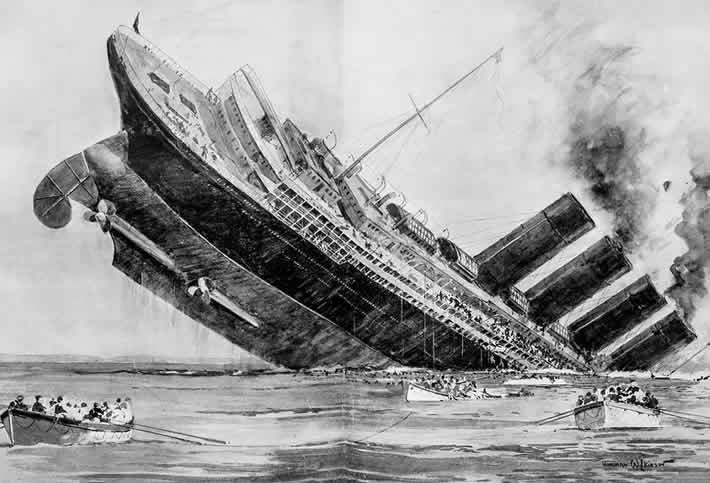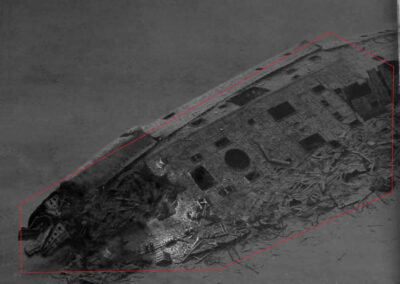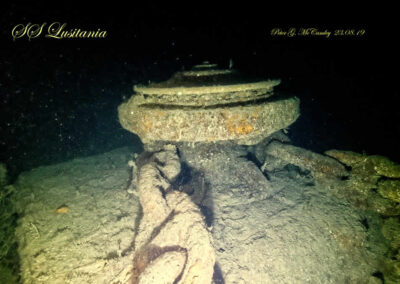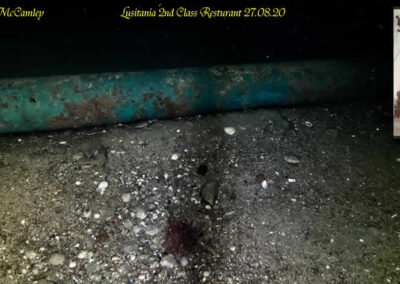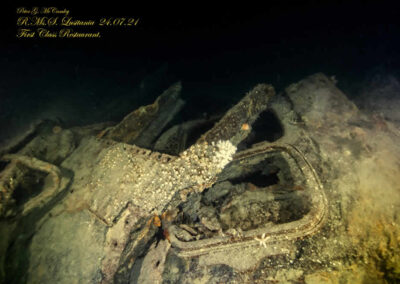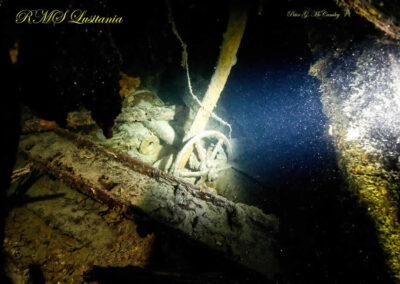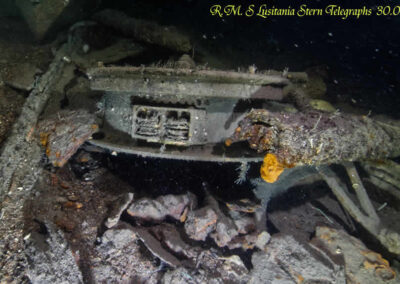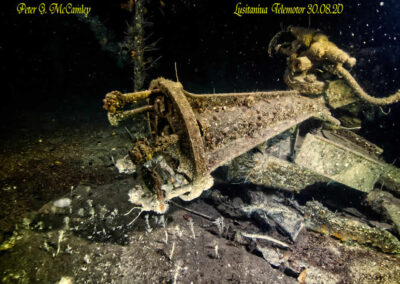Lusitania Story
August 2022
It has now been over 6 years since a group of likeminded individuals began exploring and mapping a shipwreck that sunk off Kinsale and was instrumental in bringing America into the first world war.
https://lusitaniaproject17.gastechnologies.co.uk/
The sinking by German U Boat, U20, of this 44,000 Tonne wreck was one of the reasons why America entered into the First World War on the side of the Allies. Had America not entered the First World War, the outcome could have changed history as we know it today. This huge 44,000 tonne wreck lies 11 miles off the coast of Ireland, out of Kinsale at a depth of 307 ft. The recreational diving limit is 100ft, hence, only divers with unique training, knowledge and equipment can dive to this extreme limit.
In order to safely dive to these depths, the divers need to use the latest in Closed Circuit Rebreather Technology and use a mixture of helium, air and oxygen. A 45 minutes dive on the Lusitania will normally take in excess of four hours decompression before the diver can safely exit the water and avoid the life threatening “bends”.
At the time of her build in 1906, some three years before the launch of Titanic, this ship was the fastest and most luxurious boat afloat.
The name of this wreck is RMS Lusitania.
On 07th May 2015, the fateful day when out of a total of 1960 passengers, 1197 people lost their lives. On that infamous day, the wreck of the Lusitania became Ireland’s largest monument and a mass grave that bears tragic witness to the country’s largest maritime disaster. All dives can and will only be allowed with the permission of the owners and then under a licence issued by The Department of Culture & Heritage, a division with the Government.
Since 2017, on an annual basis, a team of International Technical Divers and Researchers, working with the Underwater Archaeological Unit, a government division which issues the government licences to dive historical wrecks, have been painstaking working away on a number of projects on Lusitania in an effort to find the reasons why the great ship sank in only eighteen minutes.
These Projects involve using the latest in under water photogrammetry techniques in order to map the present condition of the wreck, were originally carried out by Kari Hyttenin & Dave Gration. At the same time, the first ever ecological study the wreck has had on its environment was carried out by Dr Claire Fitzsimmons and assisted by Steve Sanders. The results of the ecological reports have been very informative & positive.
Whilst carrying out these works, the dive team are gathering data by using high definition video and photographs in order to document and log artefacts in the hope that sooner rather than later, the artefacts will be able to be rescued and displayed at a new purpose built Lusitania Museum. This new building will be build beside the present newly restored Watch Tower which presently holds some Lusitania memorial items.
Our story, like most stories starts with one individual. This particular individual, who on visiting a doctor gets told the news that that he has a problem that requires surgery. He does not seem at all worried by the news but Peter Mc Camley, his close friend, feared the worst and decided that he would try to do something for his friend Gerry Brown. Gerry is a lifelong member of a dive club based in Newry. Peter McCamley promised Gerry, that when he recovers from the surgery somehow or other he will get his lifelong wish to dive the wreck of the Lusitania. Peter, can be very determined when he decides to do something and will do all in his power to keep his promise.
Fortunately, Gerry eventually got the all clear to dive again but during that uncertain period he and his friend, Peter manage to make contact and forge a friendship with US business man and one time chairman of three companies in the Fortune 500, Gregg Bemis, the then owner of the Lusitania
From that first emailed ’cap in hand’ request to Gregg Bemis for permission to dive the Lusitania, a remarkable roller coaster of events emerged, starting with the discovery of the largest ever ‘unintentionally’ recovered artefact from the Lusitania, by a Kilkeel fisherman, Gerry Doyle. This artefact was one of the ship’s lifeboat davits, which was actually standing in a park in a small fishing town. The ships davit is a lifting device that lowers the life boats into the water in the event of a ship sinking.
For over 10 years, Gregg Bemis had been in contact with the local council of Newry & Mourne, attempting to get the Lusitania ships davit relocated to Kinsale, where the official memorial to all those who lost their lives on Lusitania is located. What Gregg failed to understand was that due to the political situation in Northern Ireland, it was very apparent that the Lusitania davit had become a political issue.
It was in 2016, that Gerry and Peter began speaking to local politician and councillors to find out the general feelings towards the relocation. This was as good a starting place as any. It’s at this time that James McArevey and the Newry Maritime Society came on board and with their help and assistance the whole project moved up a gear. As soon as Gregg heard that there was a very good possibility of progress with the relocation, despite him suffering from illness and at a age of 89 he made the visit with his son Tim to Newry. He spent a week in Newry visiting the Doyle Family.
Sadly just weeks before his arrival, Gerry Doyle the Fisherman, now aged 88 , passed away. Gerry has only been ill for a short time before his death, however there was one remarkable thing that he did before he died. Gerry Doyle was very determined that the ships davit should be relocated to Kinsale, so determined that just days before he passed away, he wrote a letter to the council requesting that it was his final wish that the council put their differences to one side and do the sensible thing and relocate the davit. Only time would tell if his wishes would be carried out?
At that time and presently, The Government in Stormont is none existence as the political leaders simply cannot agree on policies. With no other options available, Gerry Brown, James McAreevy, The Newry Maritime Society & Peter McCamley, armed only with Gerry Doyles letter, continued meetings with different politicians and council leaders. It soon became clearly apparent, that both divides eventually agreed that the Lusitania Ships Davit should be moved to Kinsale.
On 28th April 2018, at a meeting of the Super Council in Downpatrick, a total of 38 councillors and politicians agreed unanimously that the Lusitania ships davit should be moved from Annalong to Kinsale.
The ships davit was eventually handed over by Newry & Mourne Council to The Lusitania Museum on 04th June 2018 in a ceremony which included the council chairperson and members of the Old Head Museum in Kinsale and presently the davit arm is pointing out towards the final resting place of the Lusitania.
Returning back to mid 2016, whilst attempting to relocate the Davit from Annalong to Kinsale, the dive team obtained permission from Gregg Bemis to dive the great wreck. However the application to The Irish Government fell on deaf ears. Despite over a dozen letters been sent, there was no reply. At this stage it looked very much like all the work that had been done in attempting to work on The Lusitania had been in vain as there was just simply no response from the body that held the key to what was the ultimate goal, to dive and explore Lusitania.
In a last ditch attempt, a request to made to Minister Heather Humphries who was Minister for Arts and Heritage to see if she could help as it was felt that the exploration that was planned would fall under her government brief.
Within days of contacting Minister Humphries, steps were put in motion for the exploration licence to be made available. With a strong possibility of the government licence now been agreed, it was vital that that a very fit for purpose dive team be formed. The original dive team formed the core ‘Project 17’ team of international technical divers, who would hail from Finland, England, Belgium and Ireland.
The first dives took place in August 2017 over a 2 week period. Needless to say without the assistance of The Underwater Archaeological Unit and namely Karl Brady, Fionnbarr Moore & Connie Kelleher our work on Lusitania would never have got off the ground. Project 17 are indebted to the UAU for their help and understanding.
Original Dive Team:
Frank McDermott, Rez Soheil, Steve Sanders, Jon Corlett, Clare Fitzsimmons, Dave Gration, Jimmy Lyons, David Hankin, Kari Hyttenin, Gerry Brown, Colin Brennan and Peter McCamley.
Chief Researcher: Stuart Williamson. Archaeologist: Christian Dalton and last but no means least, Lusitania diver and author, Paddy O Sullivan. Paddy and his wife Delores with the above named researchers and divers, all helped in getting and analysing the data recovered.
The sinking of the Lusitania on 7th May 1915 by the German submarine U-20 still carries a shroud of suspense, intrigue and whispers from the depths demanding some serious questions to be answered. The ship was struck by a single torpedo yet survivors were able to tell of two explosions closely following each other. Despite only one torpedo being fired, what could have caused this second explosion that in turn caused the ship to sink so rapidly in 18 minutes? It was this very small window of time that unlike Titanic, left no time for the passengers to safely abandon ship.
Of the 1197 souls that were lost on that fateful day, there were a total of 128 US civilians among them and it was this huge loss of American lives, that became the catalyst for the United States Of America joining the European Allies in the First World War against Germany.
The physical answers to what caused the second explosion hopefully can still be found lying at a depth of 93 metres 11 miles off the Old Head of Kinsale in Southern Ireland.
As interest gathered in Project 17’s first dives in 2017, the need to expand the diving and surface member team size to cope with the work load and Project 17 would now like to thank everyone involved who have helped make the diving on what is probably one of the most interesting and probably the second most famous ship wreck of all time.
In 2021, Project 17 set themselves a task that that had evaded a specialist underwater team in 2011. This was a major project that was headed by world renowned explorer, Robert Ballard, who was working with National Geographic.
The budget for the project that was available was £1.5m!
The mission was to gain access to the boilers in order to ascertain their condition. If it could be found that the boilers were intact, this would be a starting point to finding the reason for the second explosion and cast doubt on the century old theory that the second explosion was caused by coal dust which had ignited.
Since the sinking of Lusitania, on that fateful day on 07th May 2015, it was very well documented fact that it was not the single torpedo from U20 that caused the catastrophic loss of life. It was the second more deadly explosion that caused the ship to sink in only 18 minutes, hence causing such a massive loss of life. Since that time, the second deadly explosion was conveniently blamed on the accumulation of coal dust, despite the fact that liner was carrying hundreds of tonnes of munitions and forty ton of aluminium dust which is highly volatile.
Sadly the Ballard Expedition of 2011 failed to enter the boilers and obtain the relevant information.
In June 2021, Project 17, with only self-funding and armed only with an investigative passion, accumulated data and a detailed understanding from eight previous expeditions to the Lusitania, the dive team found a route into the main ships boilers. What they found was truly amazing!
To the astonishment of the dive team, all of the ships boilers were totally intact. All of this was photographed for the first time since the sinking. This revelation completely put serious doubt onto the century old coal dust theory which had been suggested by the British Establishment.
This newly found data now puts the culprit for the second explosion firmly at the foot of the 40 ton of aluminium dust. Aluminium dust is an incendiary for munitions and at the time of incident had this been revealed it would have had a very negative for The British Government. Prior to the sinking, The German Government had issued warnings that any ship found to be carrying munitions including the Lusitania, would be sunk on sight. The British Government always denied that Lusitania was carrying munitions, despite the fact it has been proved that the ship was carrying millions of rounds of .303 ammunition and hundreds of tons of materials used in the manufacture of heavy artillery.
In 2022, Project 17 returned for a 10 day period from 19th Aug, with a dive team of 22, which included divers and researchers.
During the 2022 Expedition, sadly it was discovered that the name plate which used to be visible on the port side on previous years, is now longer there. Individual letters having fallen off and been lost in the muddy bottom. The one thing that we don’t have on Lusitania is unlimited time to rescue the artefacts, which like the name plate will soon be lost forever.
One of the core members from the Core Team at Project 17, a Belgian Diver, and called Vic Verlinden has now put all of his five years photographic work into a very unique book.
Unlike other books that have been written about the Lusitania, which use library photos, Vic’s book contains his own photos that he took over the past 5 years. This has never happened before and gives the reader a good idea of what Lusitania looks like today after 107 years on the seabed.
The book is called Lusitania, The Underwater Collection has now hit the bookshelves and it can be purchased online https://gastechnologies.co.uk/publications/

